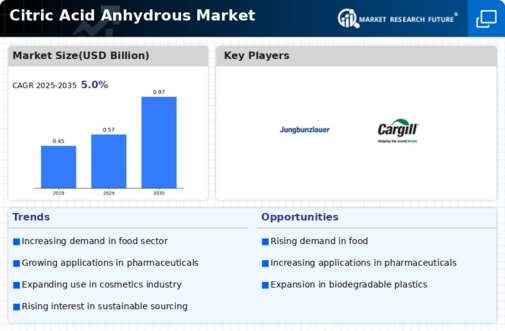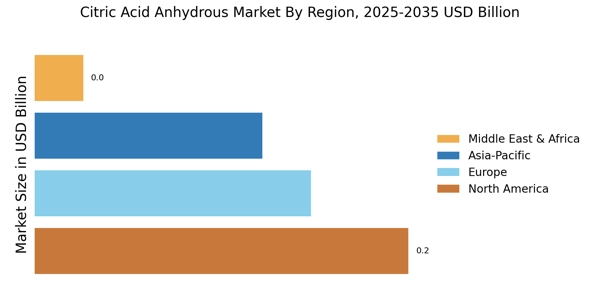Growth in Pharmaceutical Applications
The Citric Acid Anhydrous Market is witnessing a significant expansion in its pharmaceutical applications. Citric acid anhydrous is utilized as an excipient in various formulations, including effervescent tablets and syrups, due to its ability to enhance solubility and bioavailability of active ingredients. The pharmaceutical sector's increasing focus on developing innovative drug delivery systems is likely to propel the demand for citric acid anhydrous. Market data suggests that the pharmaceutical application segment is expected to grow at a rate of around 5% over the next few years, reflecting the industry's ongoing evolution and the need for effective excipients in drug formulation.
Sustainability Trends in Manufacturing
The Citric Acid Anhydrous Market is influenced by the growing emphasis on sustainability within manufacturing processes. Manufacturers are increasingly adopting eco-friendly production methods, which not only reduce environmental impact but also appeal to environmentally conscious consumers. The shift towards sustainable practices is likely to enhance the market's growth, as companies strive to align with global sustainability goals. Market data suggests that the adoption of green technologies in citric acid production could lead to a reduction in carbon emissions by up to 30%, thereby positioning citric acid anhydrous as a more attractive option for manufacturers committed to sustainability.
Rising Demand in Personal Care Products
The Citric Acid Anhydrous Market is also benefiting from the rising demand for personal care and cosmetic products. Citric acid anhydrous is recognized for its ability to act as a pH adjuster and exfoliant, making it a valuable ingredient in skincare formulations. As consumers increasingly seek products that are both effective and gentle on the skin, the incorporation of citric acid anhydrous aligns with these preferences. The market data indicates that the personal care segment is projected to grow at a compound annual growth rate of approximately 4% in the coming years, driven by the trend towards natural and organic formulations.
Increasing Application in Food and Beverages
The Citric Acid Anhydrous Market experiences a notable surge in demand due to its extensive application in food and beverage products. As a natural preservative and flavor enhancer, citric acid anhydrous is favored by manufacturers aiming to meet consumer preferences for clean-label products. The market data indicates that the food and beverage sector accounts for a substantial share of the overall citric acid consumption, with projections suggesting a growth rate of approximately 4.5% annually. This trend is driven by the rising inclination towards healthier food options, where citric acid serves not only as a flavoring agent but also as a pH regulator, thereby enhancing product stability and shelf life.
Technological Advancements in Production Processes
The Citric Acid Anhydrous Market is experiencing a transformation due to technological advancements in production processes. Innovations such as fermentation technology and bioprocessing are enhancing the efficiency and yield of citric acid production. These advancements not only lower production costs but also improve the overall quality of the final product. Market data indicates that the implementation of these technologies could potentially increase production efficiency by 20%, thereby meeting the rising demand across various sectors. As manufacturers continue to invest in research and development, the citric acid anhydrous market is likely to witness sustained growth driven by these technological improvements.


















Leave a Comment